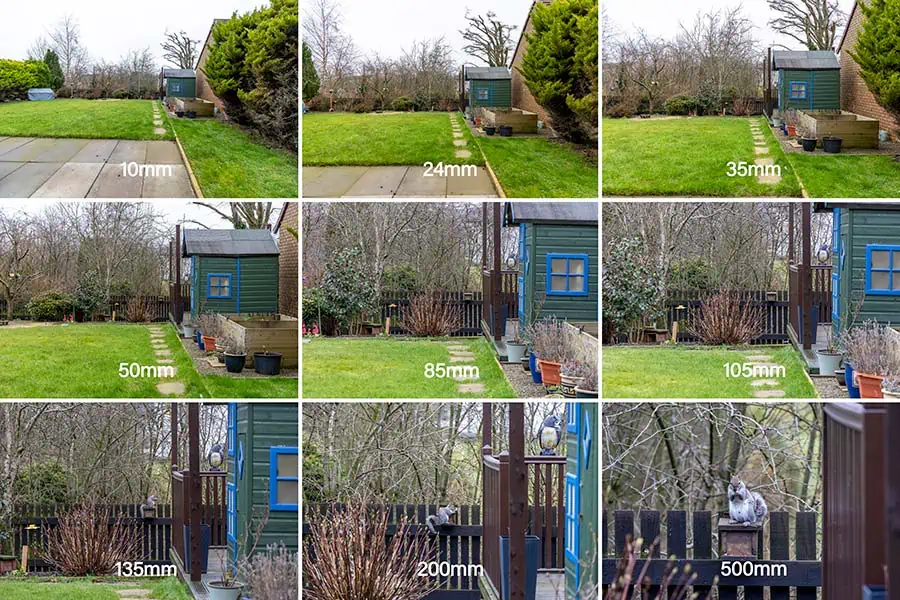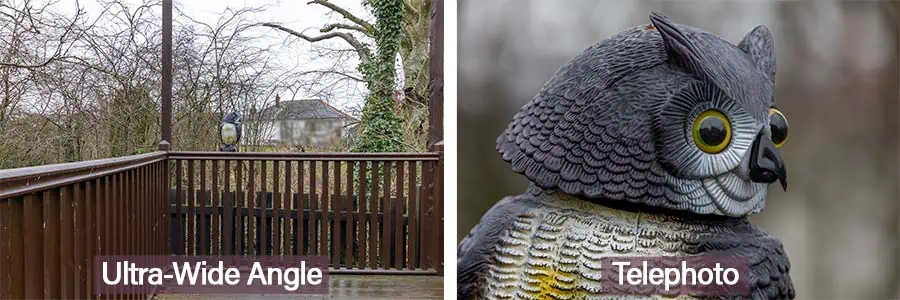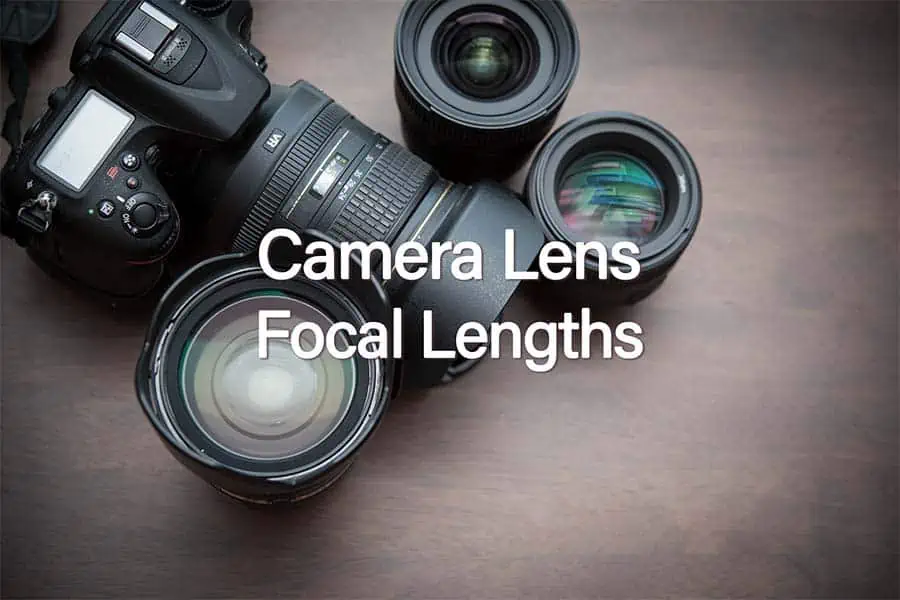DIY Video Studio is supported by its readers who use the affiliate links or ads on this site. As an Amazon Associate, I earn from qualifying purchases. Thank your support if you use any of the links.
Author: Tosh Lubek Published: 2 February 2023
Understanding lens focal length and the effect it has on your photos and videos is important if you want to unleash your creative potential and capture stunning images.
So, which type of lens should be used with a camera body?
Well, there is no single lens that is ideal for every situation. This explains why there are so many different lenses and focal lengths. The focal length determines the amount of image magnification, the field of view, and to an extent, the ability of the lens to produce a shallow or wide depth of field. In this guide, I explain the main types of lenses used in photography, their common uses, and what focal lengths are best suited for each type of photography.
The following image is of the same subject, a squirrel peanut feeder on the fence of my backyard, but taken at 9 different focal lengths: 10mm, 24mm, 35mm, 50mm, 85mm, 105mm, 200mm, and 500mm. You can see that the feeder, and the squirrel, are clearly the subject of the scene, but at much shorter focal lengths the backyard is the subject.

The Basics of Focal Length and Angle of View
In photography, the focal length of a lens, which is measured in millimeters, determines how magnified the subject appears in the image, and therefore, the field of view, or how much of the subject will appear in the image. As focal length increases, so does the magnification but the field of view decreases. So, wide-angle lenses, such as fish-eye lenses, with short focal lengths, produce a wide field of view, while telephoto lenses, which have longer focal lengths, produce magnified images that show more detail at the expense of showing less of the subject.
Understanding focal length is vital since it directly impacts the look and perspective of an image. It can alter the relationship between foreground and background elements, the detail captured, and the sense of depth in the image. For instance, a wide-angle lens can capture a vast landscape, but a telephoto lens can isolate an interesting feature within the landscape.
Focal length also influences the amount of compression in an image. Longer focal lengths compress space, making objects at different distances appear closer together. This is something landscape photographers need to be aware of.
In photography, the focal length of a lens can range from just a few millimeters to hundreds of millimeters. Each can be classified as being a Wide Angle, Standard/Normal, or Telephoto lens. But as the commonly available range of focal lengths has increased, these three categories can be subdivided, although not everyone might agree where one category ends, and another one starts. But the separate categories are as follows:
- Fisheye
- Ultra-Wide
- Wide
- Standard/Normal
- Short Telephoto
- Telephoto
- Super Telephoto
The following table shows the general focal range associated with each of these categories and the typical uses for each type.
| Focal Length (mm) | Lens Type | Typical Uses |
| 8-15 | Fisheye | Landscapes, Abstract Art |
| 10-20 | Ultra-Wide | Architecture, Landscapes |
| 14-24 | Wide | Landscapes, Interiors |
| 24-70 | Standard | Portraits, Landscapes, Street |
| 70-135 | Short Telephoto | Portraits, Landscape, Street |
| 70-200 | Telephoto | Portraits, Sports, Wildlife, Landscape |
| 200-800 | Super Telephoto | Wildlife, Sports |
Note that the magnification and field of view of a lens intended for a full-frame camera may appear different when used on a crop sensor camera. Since the crop sensor camera only uses the middle portion of the image formed by the lens, the image will appear magnified.
One other thing that is worth mentioning about lens focal length is how it affects the depth of field. When using a short focal length (wide-angle lens), the depth of field will be large. For example, when using a 16mm f4.5 lens the depth of field is pretty much infinite. To get any kind of background blur you will need to get close to your subject.
Standard Lenses for Everyday Use
Standard lenses, sometimes called Normal lenses, are probably the workhorses of photography since they offer the photographer a high degree of versatility. The focal length range of standard lenses falls between 24-70mm. Many of the kit lenses supplied with camera bodies often cover this range of focal lengths. They are the everyday lens that can work in a broad range of situations. With its moderate focal length, it provides a natural perspective, making it a popular choice for a wide range of photography applications, from portraits to landscapes.
The archetypal standard lens is the 50mm f1.8, often referred to as the nifty-fifty. The focal length of 50mm is ideal for portraiture, street photography, and other types of shooting where you want to capture the subject in their environment. It offers a pleasing level of background compression and distortion control. In portraiture, faces look normal when shot with a 50mm lens compared to the distorted look when taken with a wide-angle lens.
However, because of the limited focal length, standard lenses may not be the best choice for certain types of photography, such as landscape, sports, and wildlife photography.
Wide-Angle Lenses for Capturing More of a Scene
Wide-angle lenses are those with focal lengths shorter than those of standard lenses. This can be from 24mm and lower, although some people may say 50mm and lower. For example, Cannon class their RF35mm f1.8 as a wide-angle lens, however, the visual result is not wildly different from that taken with a 50mm standard lens.
Wide-Angle lenses can be split into three categories, Fisheye (8-15mm), Ultra-Wide, and Wide (14-24mm). They are popular for landscape photography, as they allow photographers to capture a wide view in a single shot. Wide-angle lenses can also be used for architecture and interiors, where you need to take in more of the scene.
Fisheye lenses: These offer the widest view but at the expense of distortion and a distinctive perspective. However, they can capture a 180-degree field of view, which is ideal if you are a meteor-hunting astrophotographer needing to capture the entire sky or you want to create artistic images with the lens’ distorted perspective.
Ultra-wide lenses: These have a focal length of typically 10-20mm. They are designed to capture a wide field of view, making them ideal for shooting large structures, sweeping landscapes, panoramas, interiors, and architecture. When using ultra-wide lenses for portraiture, faces can look weird due to distortion effects. Not only can the width of the face seem narrower but facial features that are nearer to the lens appear unnaturally larger and further away parts can seem smaller. So, noses tend to be enlarged and ears shrunken. It’s similar to the effect you get when taking a selfie on your phone. Place your hand at the side of your head and it looks normal sized, but move your hand forwards a little and it starts to seem enormous.
Wide lenses: These have a focal length range of 14-24mm. Unlike ultra-wide lenses, wide lenses provide a more natural perspective and can produce images with less distortion. In terms of focal length and the look they produce, wide lenses are closest to standard lenses. They are frequently the go-to focal lengths for landscapes, interiors, and architecture. At the longest end of their focal length range, they can provide the photographer with the option of showing a subject with a good amount of the surrounding environment in a single shot.
If you need a wide-angle lens, but not anything as extreme as a fisheye, look for one with a focal length between 14mm and 35mm. For more flexibility choose a zoom, with good examples being the Canon RF 15-35mm f2.8L, Canon RF 14-35mm f4 L, or Sony FE 16-35mm f2.8 GM. This focal length range is ideal for a range of scenarios, and at 35mm, it’s even a passable standard lens focal length.
Telephoto and Super-Telephoto Lenses for distance shooting
Telephoto lenses: These have a focal length of more than about 50mm and up to around 250-500mm. They are useful when you want to reveal plenty of subject detail. A telephoto lens lets you photograph animals, sports, and many other subjects that you just couldn’t get close enough to if you used a shorter lens. Another important point is that these lenses let you get your shots without disturbing wildlife or interrupting a sporting event.
However, there can be some overlap in the type of subject matter for wide, standard, and telephoto lenses. For instance, 50mm, 85mm, and 135mm focal lengths would all be acceptable choices for portrait photography. Despite the first being a standard lens and the other two being telephoto lenses. Furthermore, although landscape photographers might traditionally carry something like a 15-35mm zoom, it’s not out of the question that they would also have a 70-200mm zoom lens in their kit bag.
Although portrait photographers might use a range of focal lengths from 50-135mm, the general preference is a fast 85mm lens (f1.2 or f1.4). This would give a natural-looking perspective with the ability to blur the background, without the need to get too close to the subject.
Earlier on I mentioned that focal length can also have an impact on the depth of field. I said that wide-angle lenses can even have an infinite depth of field, so everything is effectively in focus. Well, guess what happens when you use a telephoto lens that has a long focal length? That’s right, even at high f-stops the depth of field can be very shallow, especially if you are close to the subject (relatively speaking). So, it is easy to capture portraits with blurred backgrounds when using a telephoto, which helps to isolate the subject from the background and create beautiful bokeh.
In the following image pair, I compare the image of a fake owl taken with an Ultra-Wide angle lens (18mm) to an image shot with a telephoto lens (500mm). To keep things equal, both shots are at f7.1 (the fastest aperture on the telephoto lens) and the distance is the same, about 10ft). You can see that in the image shot with the ultra-wide lens, almost everything appears in focus (ignore the part of the house I have blurred for privacy reasons). Meanwhile, the shot with the 500mm telephoto lens clearly shows a shallow depth of field. My focus point is the left eye, yet the eye on the right is a little soft and the ear on the right (about 2-3 inches further back than the left eye) is obviously blurred. Consequently, there is considerable bokeh in the background, with the trees and bushes just 6ft behind the owl being completely blurred.

Super-telephoto lenses: These are like telephoto lenses but on steroids! Although many would say the super-telephoto starts at about 200mm, I would be more comfortable with starting at around 300mm, but their focal lengths can go up to about 600mm, 800mm, or even 2000mm. This amount of “reach” allows photographers to capture detail that would be impossible to photograph in any other way. However, these lens leviathans come with some drawbacks. For instance, if they are primes lenses they can be large, heavy, and very expensive. The Canon RF 800mm f5.6 L IS USM lens is about $17,000, while the RF1200mm F8 L IS USM lens comes in at about $20,000. But if you are a professional photographer, these lenses might be invaluable since they will allow you to get certain types of shots. Fortunately, there are cheaper alternatives, such as the Canon RF600 and 800mm f11, and those by Sigma and Tamron.
Macro Lenses for Close-Ups
Macro lenses are used for taking detailed photographs of very small subjects, such as flowers, insects, and other small details. The magnification of a true macro lens is 1x, with a reproduction ratio of 1:1. What this means is that a subject that is 1cm long will have an image projected onto the sensor that is 1cm long. In other words, the subject size and the image size are the same.
Macro lenses allow for creative shots that reveal great detail, however, they can exhibit a shallow depth of field. So if the subject has great relative depth, the front may be in sharp focus but the furthest away part may appear to be blurred. If the subject does not move, the shallow depth of field can be overcome by using the technique of focus stacking, where multiple images are taken, gradually shifting the focus point, and then combining the images in software like Photoshop.
Macro lens focal lengths range from about 35mm to around 200mm, with many popular macro lenses having a focal length of 100mm.
Conclusion
As a photographer, it’s crucial to understand how the focal length of the lens can impact your images. In this article, I covered the various focal lengths of lenses and their typical uses in photography, starting from fisheye lenses through to super-telephoto and macro lenses.
It’s vital to remember that the focal length of a lens determines the field of view, depth of field, and the amount of compression in an image. This makes it an important factor to consider when choosing a lens for your photography.
To ensure that you’re always prepared to capture the perfect shot, it’s recommended to have a trio of lenses. The specific lenses you require will depend on your photography style. Nevertheless, the combination of 16-35mm, 24-70mm, and 70-200mm will provide you with the flexibility to handle many situations. Unless you are a wildlife or sports photographer you probably don’t need a 100-500mm or longer.
Ultimately, the best way to find the right lens for your photography style is to experiment with different lenses and see how they impact your images. Don’t be afraid to try out new lenses and have fun finding the best fit for your individual photography needs.
You might also like…
Here’s a big ask from me: If you liked this article, please share it.
It will mean a great deal to me if you share this post because a few seconds of your time will seriously help my blog grow. The share buttons are below the “About Author” section.
Thanks. 🙂
About the author: Tosh Lubek is a multi-award-winning broadcaster, writer, and video producer, with 40 years of experience in professional broadcasting and has been using Canon video and stills cameras since 2010. He has worked with radio and TV broadcasters, advertising agencies, and direct clients on a variety of projects including radio and television advertising, online video production, corporate videos, award ceremony motion graphics, and theme park sound design. Tosh has won numerous awards, including a Radio Academy Awards Gold Sony, a Gold, Silver, and Bronze World Medals in the New York Festivals International Advertising Awards. Since about 2007 he has been creating YouTube videos. Tosh has been a sponsor of the “video booth” at HashTag Business Events across the UK.
Recent Posts
You're Using the Canon RF 50mm f/1.8 WRONG! Here’s How to Fix It
If you’ve recently picked up the Canon RF 50mm f/1.8 STM—affectionately known as the Nifty Fifty—you might be confused by that strange switch on the side of the lens. It doesn’t say AF/MF...
Recently, I shot several customer testimonial videos in 4K for a client when the overheating warning on my Canon EOS R6 appeared. In fact, it appeared three times in five sessions during the day of...



